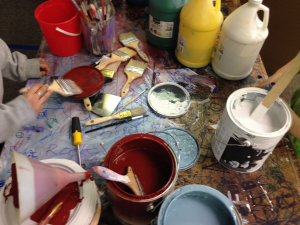3. The Solution
I decided to create an after-school club called Big Paintings. I initially envisioned Big Paintings Club as a way for my students to explore the act of large format painting. I wanted to offer large format paintings because as children grow older their creative options diminish. It is common to see large easel painting activities in Pre-K and Kindergarten classrooms (Fromberg, 2012). However, “with each passing year that a child spends in school, art recedes further from the curriculum” (Cole, 2012, p.74). I was curious to see what a small group of fifth graders, unencumbered by the constraints and practices of traditional art room settings, would produce when given space, time and a variety of materials. Although the club was conceived as a way for students to create large paintings, that concept served as a springboard for new approaches to creativity. Big Paintings Club provided a way for the children to start thinking about art as something more than the tightly prescriptive, bulletin board friendly drawings and paintings they had been accustomed to producing in school environments. It provided the students opportunities to engage in the artistic process free from school art conventions such as exemplars, templates, standards, rubrics, or teacher-directed instruction on materials and techniques.
American art critic Harold Rosenberg famously conceptualized Action painting as “an arena in which to act” where each painting became “not a picture but an event” (1960, p. 25). I thought this would be a good place to begin. Instead of pre-established paradigms I sought to provide an open framework and malleable structure wherein my students could approach the act of painting in their own way.
Big Paintings Club was scheduled to take place for an hour on Friday afternoons over the course of four consecutive weeks. Six students enrolled in the club and each was supplied with 4 by 4 foot sections of heavyweight double-sized paper, one 4 by 4 foot hardboard panel, art and house paint brushes in a variety of sizes, rollers, putty knives, pencils, latex house paint and school grade tempera paint. My approach could not guarantee specific outcomes nor adhere to a set criterion of learning standards. I could only promise that the students would be allowed to engage in the creative experience similar to contemporary working artists. Lisa Wainwright, from the School of the Chicago Art Institute, describes the artist’s studio as a space where “creative play and progressive thinking” serve as a platform “to reflect, critique, and innovate” (2010, p. ix). Using play as a pathway to innovation is difficult to put into practice in a place where schedules, timelines, rubrics, and assessments are prevalent.
Even as an after school program Big Paintings Club was a radical departure from the norm. I supplied the materials and set up the space but what the students did with the materials and how they worked within the space was left up to them. I made it clear that they were working as artists. Their time was their own. They could paint if they felt like it. They could show up or not. I simply offered studio space where the students were allowed to create on their own terms. I acted as a mentor, facilitator and documentarian. I responded to questions and offered thoughts and ideas but my primary role was that of a studio assistant. I helped pour paint, set up drop cloths, and clip paintings to the large Masonite boards. I fetched materials and cleaned brushes. After the students left I straightened up the studio space and readied the classroom for school on the following Monday.

While they painted I mostly watched and listened. If a need arose, I did my best to provide a solution. I did not want to interfere with their processes or direct their outcomes. When questioned directly, I gave feedback on aesthetics, methods or techniques. I was careful not to present myself as an authority but as a resource available to support their individual creative journeys.
Each week I placed the supplies in front of the students and observed what happened. I used my iPhone to take photographic and video evidence of the processes and the final products. These electronic files along with my personal journal entries made up the data set for this study allowing me to examine the effects of artistic agency on the self-initiated creativity of elementary school children.